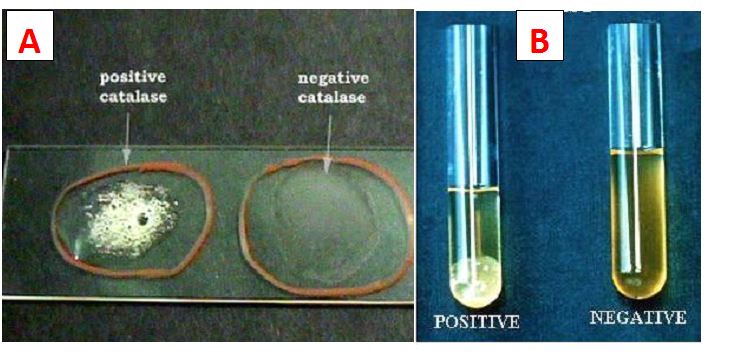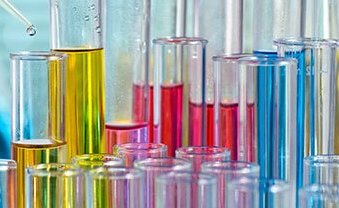Coagulase test is used to distinguish pathogenic Staphylococcus aureus (which is coagulase positive) from nonpathogenic strains of S. aureus (which is coagulase negative). This test is used to differentiate Staphylococcus aureus (positive) from Coagulase Negative Staphylococcus (CONS). Coagulase is an enzyme produced by S. aureus that converts (soluble) fibrinogen in plasma to (insoluble) fibrin. Staphylococcus aureus produces two forms of coagulase, bound and free. Coagulase is an enzyme that causes blood plasma to clot.
The enzyme is a key virulence factor in the pathogenicity of pathogenic S. aureus because the clot formed helps to shield the bacterium from phagocytosis. Free coagulase reacts with a plasma cofactor called coagulase reacting factor (CRF) to produce coagulase-thrombin (a thrombin-like particle) which promotes the change from fibrinogen to fibrin forming a clot called coagulum.
Free coagulase (detected by tube coagulase test) and bound coagulase (detected by slide coagulase test) are the two types of coagulase enzymes produced by pathogenic strains of S. aureus. Coagulase test can be performed in two ways viz: slide method (using a clean glass slide) and tube method (using test tubes).
SLIDE METHOD OF COAGULASE TEST
- Use pure cultures from solid culture media (preferably BA) to perform this test.
- Divide a clean glass slide into two parts using a grease pencil.
- Place a drop of normal saline or distilled water on each side of the slide.
- Pick a colony or speck of the overnight culture using a sterilized inoculating loop.
- Emulsify the culture with each of the drops of normal saline to form a homogeneous suspension. This must be separately done for each side of the slide.
- Add a drop of plasma (from human or animal origin) to only one of the suspensions on the slide and stir for about 5 secs.
- Lookout for clumping which does not re-emulsify. Presence of clumping indicates a positive test (Figure 1).
- The other portion of emulsified culture without plasma remains the same and serves as the negative control of the test.

TUBE METHOD OF COAGULASE TEST
- Wash three small test tubes thoroughly.
- Label each of the tubes as tube A (test culture tube), tube B (positive control), and tube C (negative control).
- Aseptically dispense 0.5 ml of plasma into each of the three tubes.
- Add 0.5 ml of the test broth culture to tube A.
- Add 0.5 ml of S. aureus culture to tube B (positive control tube).
- Add 0.5 ml of sterile broth to tube C (negative control tube).
- Incubate all tubes at 37oC after proper mixing.
- Observe the tubes hourly for the presence of clotting. It is vital to tilt or slant the tubes when looking out for clotting (Figure 1).
- Presence of coagulation within 1-4 hrs indicates a coagulase positive test.
References
Basic laboratory procedures in clinical bacteriology. World Health Organization (WHO), 1991. Available from WHO publications, 1211 Geneva, 27-Switzerland.
Beers M.H., Porter R.S., Jones T.V., Kaplan J.L and Berkwits M (2006). The Merck Manual of Diagnosis and Therapy. Eighteenth edition. Merck & Co., Inc, USA.
Biosafety in Microbiological and Biomedical Laboratories. 5th edition. U.S Department of Health and Human Services. Public Health Service. Center for Disease Control and Prevention. National Institute of Health. HHS Publication No. (CDC) 21-1112.2009.
Cheesbrough M (2010). District Laboratory Practice in Tropical Countries. Part I. 2nd edition. Cambridge University Press, UK.
Cheesbrough M (2010). District Laboratory Practice in Tropical Countries. Part 2. 2nd edition. Cambridge University Press, UK.
Collins C.H, Lyne P.M, Grange J.M and Falkinham J.O (2004). Collins and Lyne’s Microbiological Methods. Eight edition. Arnold publishers, New York, USA.
Disinfection and Sterilization. (1993). Laboratory Biosafety Manual (2nd ed., pp. 60-70). Geneva: WHO.
Garcia L.S (2010). Clinical Microbiology Procedures Handbook. Third edition. American Society of Microbiology Press, USA.
Garcia L.S (2014). Clinical Laboratory Management. First edition. American Society of Microbiology Press, USA.
Fleming, D. O., Richardson, J. H., Tulis, J. I. and Vesley, D. (eds) (1995). Laboratory Safety: Principles and practice. Washington DC: ASM press.
Dubey, R. C. and Maheshwari, D. K. (2004). Practical Microbiology. S.Chand and Company LTD, New Delhi, India.
Gillespie S.H and Bamford K.B (2012). Medical Microbiology and Infection at a glance. 4th edition. Wiley-Blackwell Publishers, UK.
Discover more from #1 Microbiology Resource Hub
Subscribe to get the latest posts to your email.


